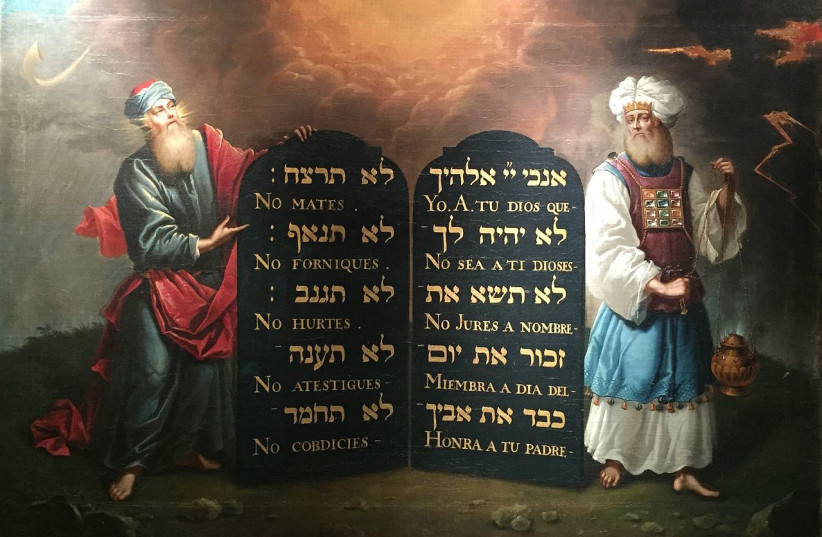The pinnacle of this week’s parasha, Yitro, is the giving of the Torah.
For that rendezvous and theophany, Moses, at the age of 80, had climbed to the top of Mount Sinai to meet God.
There, Moses received what is often called the Ten Commandments, but that name is not found in the Torah. They are called aseret hadvarim (Ex. 34:28; Deut. 4:13, 10:4), which can be understood as the 10 words/statements/pronouncements. That phrase was eventually translated into Greek by the ancient Jewish community of Alexandria as deka logi, which became Decalogue in English. However, the rabbis used the phrase “aseret hadibrot” (the 10 utterances).
As Yosef Lindell explains: “Scholars have also theorized that the very term ‘aseret hadibrot,’ which is different than the language ‘aseret hadvarim’ used in the Torah, was invented by the Sages to dispel any notion that these are the most important commandments. ‘Aseret hadvarim’ literally means 10 statements, but can also be understood as 10 commandments – perhaps, one might erroneously think, uniquely important commandments. Dibrot, on the other hand, is not the plural of davar, a thing, but of diber, speech. What is more, diber, which appears only once in Tanach as a noun, connotes not just any kind of speech, but specifically revelatory speech.”
“Scholars have also theorized that the very term ‘aseret hadibrot,’ which is different than the language ‘aseret hadvarim’ used in the Torah, was invented by the Sages to dispel any notion that these are the most important commandments. ‘Aseret hadvarim’ literally means 10 statements, but can also be understood as 10 commandments – perhaps, one might erroneously think, uniquely important commandments. Dibrot, on the other hand, is not the plural of davar, a thing, but of diber, speech. What is more, diber, which appears only once in Tanach as a noun, connotes not just any kind of speech, but specifically revelatory speech.”
Yosef Lindell
What about the phrase “Ten Commandments”?
We find its usage first in the Geneva Bible, published in 1560, about 50 years before the King James Bible, which also used the “Ten Commandments” wording. It is called the Geneva Bible because it was written by a group of Protestant scholars in exile from England, including John Knox, in Geneva, Switzerland. They were influenced in their work by John Calvin.
THERE IS another aspect of aseret hadibrot that invites attention. There are two different versions of them in the Torah. The first appears in Exodus (20:2-14) and the other in the Book of Deuteronomy (5:6-18).
According to biblical scholars, if we look closely at the text we can find four distinct voices, based on linguistics, terminology, content, themes, and other writing styles. This theory is known as the documentary hypothesis, which culminated in a redactor (one who combines/synthesizes text) weaving the four voices together within the text sometime around the fourth century BCE into the version of the Hebrew Bible we know today.
While historically I find this approach compelling, it does nothing for me theologically or spiritually, so I am drawn to the inherent contradictions within the Bible, not as proof of the documentary hypothesis, which I do believe to be true, but rather as invitations to draw lessons from those contradictions.
Nor do I believe that accepting the documentary hypothesis takes away from the holiness of the Bible. If we understand that something holy is a synapse within the universe that connects us to, as Rev. Martin Luther King said, “the interrelated structure of reality,” that perspective can enhance our understanding of its words as holy.
Let us look at the Fourth Commandment, which tells us how to observe Shabbat. Below are the two versions with their differences italicized:
“Remember the sabbath day and keep it holy. Six days you shall labor and do all your work, but the seventh day is a sabbath of the Lord your God: you shall not do any work – you, your son or daughter, your male or female slave, or your cattle, or the stranger who is within your settlements. For in six days the Lord made heaven and earth and sea, and all that is in them, and He rested on the seventh day; therefore the Lord blessed the sabbath day and hallowed it” (Ex. 20:8-11).
“Observe the sabbath day and keep it holy, as the Lord your God has commanded you. Six days you shall labor and do all your work, but the seventh day is a sabbath of the Lord your God; you shall not do any work – you, your son or your daughter, your male or female slave, your ox or your ass, or any of your cattle, or the stranger in your settlements, so that your male and female slave may rest as you do. Remember that you were a slave in the land of Egypt and the Lord your God freed you from there with a mighty hand and an outstretched arm; therefore the Lord your God has commanded you to observe the sabbath day” (Deut. 5:12-15).
While there are a number of differences, I would like to explore the focus at the end of each version. In Exodus we are told to think about the Creation story, while in Deuteronomy we are told to remember slavery. Why are there two different points of reference for our weekly day of rest?
Jeremy Benstein offers an insightful answer from a class we co-taught at the Arava Institute for Environmental Studies.
He points out that the difference between the Book of Exodus and the Book of Deuteronomy is 40 years. Moses had two very different audiences before him. One had just left slavery 50 days earlier, while the other audience was the children and grandchildren of those slaves, who had never known slavery.
Benstein says that it would make no sense to tell a group of people who had just left slavery that on their one day of the week when they did not have to work, they were to think about once being slaves. It would, however, make sense to have them reflect on being created anew as free people, and so thinking about Creation would be logical. Forty years later, a new generation being told to remember slavery so as not to take liberty for granted would present an important message.
Moses teaches us a very important lesson when it comes to effective communication: Know our audience. As Samara Johansson, the founder of Samara Global, states, “It all starts with being curious and humble; putting yourself in the shoes of your audience and going on the journey with them”
Moses knew his audience, and by meeting them where they were, he was able to lead them.
He continues to teach us today on our individual and collective journeys as we wrestle with the meaning of his words, those holy words.■
The writer, a Reconstructionist rabbi, is rabbi emeritus of the Israel Congregation in Manchester Center, Vermont. He teaches at the Arava Institute for Environmental Studies on Kibbutz Ketura and at Bennington College.

